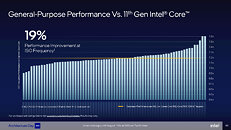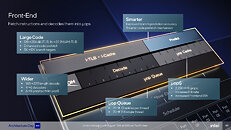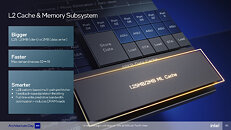Thursday, August 19th 2021

Intel Golden Cove P-Core Offers 19% IPC Gain Over Cypress Cove (Rocket Lake)
The 8 "Golden Cove" performance cores (P-cores) present on 12th Gen "Alder Lake-S" desktop processors offer an IPC gain of 19% over the "Cypress Cove" cores powering current 11th Gen "Rocket Lake-S" processors, claims Intel. This would put them at roughly 35% higher IPC than the "Skylake" cores that powered Intel client desktop processors until as recently as 2020, with the 10th Gen "Comet Lake." This 19% number, however, is presented as a geomean of performance improvement at iso-frequency, across a wide selection of tests that include SPEC CPU 2017, SYSmark 25, Crossmark, PCMark 10, WebXPRT3, and Geekbench 5.4.1.
The high IPC of the P-cores, coupled with the high rumored frequencies for the enthusiast i9-12900K part running well into 5.30 GHz or beyond, begins to explain how 8 of these "Golden Cove" cores, coupled with 8 fairly fast "Gracemont" cores, closes in on the 16-core AMD Ryzen 9 5950X at Cinebench R20.The "Golden Cove" performance core achieves this 19% IPC gain over its desktop predecessor by being "wider, deeper, and smarter." Any x86 core includes three basic components, the front-end, the execution stage, and the load/store stage. The front-end of "Golden Cove" sees a double-sized instruction-TLB, a "smarter" branch predictor; and double-wide decode unit. There are numerical increments to the decode unit, micro-op queue, and micro-op cache. The out-of-order (OoO) engine sees similar increments, with 6-wide allocation and 12-wide execution ports, compared to 5-wide and 10-wide for "Cypress Cove," respectively. The execution stage sees the addition of a 5th execution port and ALU; FMAs with FP16 support; and an updated FADD (fast adder). Similar improvements are made to the cache and memory sub-system. 1.25 MB is the size of the dedicated L2 cache for client versions of "Golden Cove," and 2 MB for server/HEDT versions.
The high IPC of the P-cores, coupled with the high rumored frequencies for the enthusiast i9-12900K part running well into 5.30 GHz or beyond, begins to explain how 8 of these "Golden Cove" cores, coupled with 8 fairly fast "Gracemont" cores, closes in on the 16-core AMD Ryzen 9 5950X at Cinebench R20.The "Golden Cove" performance core achieves this 19% IPC gain over its desktop predecessor by being "wider, deeper, and smarter." Any x86 core includes three basic components, the front-end, the execution stage, and the load/store stage. The front-end of "Golden Cove" sees a double-sized instruction-TLB, a "smarter" branch predictor; and double-wide decode unit. There are numerical increments to the decode unit, micro-op queue, and micro-op cache. The out-of-order (OoO) engine sees similar increments, with 6-wide allocation and 12-wide execution ports, compared to 5-wide and 10-wide for "Cypress Cove," respectively. The execution stage sees the addition of a 5th execution port and ALU; FMAs with FP16 support; and an updated FADD (fast adder). Similar improvements are made to the cache and memory sub-system. 1.25 MB is the size of the dedicated L2 cache for client versions of "Golden Cove," and 2 MB for server/HEDT versions.








32 Comments on Intel Golden Cove P-Core Offers 19% IPC Gain Over Cypress Cove (Rocket Lake)
i want this!
Golden Cove is the successor to Willow Cove with basically the same big L2/L3 setup. Cypress Cove was a shitty port of Sunny Cove, both have only the larger L1 but L2/L3 roughly on par with Zen 2.Probably because to achieve desired performance it would consume 10980XE levels of power, at 10ESF density, in a LGA1700 package, so basically uncoolable :laugh:
People buy desktops to get the absolute max performances, and Intel is cutting out a large chunk of those potential performances just to save a few watts under small loads. It will be easy for any competitor to just release 16 full speed cores and win, I don't understand Intel move here.
Your looking at lower power use in standby or web browsing or video playback, possibly.
When works being done that's going straight outta the window(140/250watts), but we will see.
My browsing already couldn't get much more efficient personally, a pc can't beat a phone at browsing.
And yeah AMD has 16 cores max for the 5950 not 32. Threadrippers are HEDT and they are different and the price segment is different so i dont think you should consider these as desktops.
But it would be better if we get some hardcore cpu's again that sets competition sharp and better in pricing for us as consumers.
And they're comparing to Zen 3 with zen3+ and it's additional 25% imminent.
I'll agree on thread ripper, and the marketing.
Or B: their only way to compete in the core wars due to monlithic design limits in power consumption, die size, cost etc...
Indeed 16 cores and 16 threads just 8 of these cores are low bins guess people are used to 8 core 16 threads now days lol
Intel isn't binning the same as in the past where they disabled really bad cores.
Real question is, how bad/ hot will these small cores get at the same frequency as the large/ good cores, probably not too bad seeing hyper threading is disabled on them.
They can only make a core faster than a Ryzen core by designing a massive core, massive.
So they have, but 16 of those would shut down celafield .
Soo they dragged out their atom core's, gave them a polish and hey presto 90% of the user's, 90% of the time will actually have their big cores dark ,shut down while they stare at Google Chrome running on the pipsqueak core's.
They can claim single core crown while claiming an efficiency crown, not, and a level of core parity in gen publicos eye's.
But you'll pay, obviously.